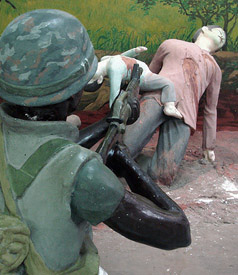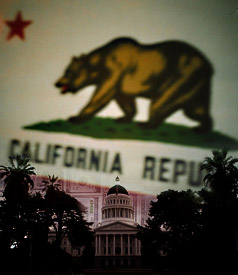
Friday, September 25, 2009
Forty Years Later Calley Speaks Up

by Carol Becker
 On August 19, 2009, former Army Lt. William Calley spoke to a Kiwanis Club meeting in Greater Columbus, Georgia, and for the first time publicly admitted his regret for his role in the My Lai massacre. "There is not a day that goes by, " he said, "when I do not feel remorse for what happened that day in My Lai. I feel remorse for the Vietnamese who were killed, for their families, for the American soldiers involved and their families. I am very sorry."
On August 19, 2009, former Army Lt. William Calley spoke to a Kiwanis Club meeting in Greater Columbus, Georgia, and for the first time publicly admitted his regret for his role in the My Lai massacre. "There is not a day that goes by, " he said, "when I do not feel remorse for what happened that day in My Lai. I feel remorse for the Vietnamese who were killed, for their families, for the American soldiers involved and their families. I am very sorry."
For those of us who grew up in the intensity of the 1960's and in the pain of the Vietnam War, this long-awaited admission stirred deep emotion. Calley had always been symbolic of the brutality of those times and of the cover-up of horrific acts by individuals and the US government. He also represented the country's polarization between those who opposed the war and those who turned men like Calley into heroes. That he could finally say how desperately painful his life has been since that horrific event has allowed us all to continue a process of disclosure and healing that is still necessary, forty years later, if we are to recover from that war. Vietnam the war has never really ended for those in the US who grew to adulthood in its shadow, because of the depth of denial. We, as a nation, have not been able to say: "This should not have occurred." As a result, we continue to engage in other fabricated wars and to create new generations of soldiers and civilians on all sides of these conflicts who cannot recover from the trauma of what they have experienced.
U.S., NATO Poised For Most Massive War In Afghanistan's History

 Over the past week U.S. newspapers and television networks have been abuzz with reports that Washington and its NATO allies are planning an unprecedented increase of troops for the war in Afghanistan, even in addition to the 17,000 new American and several thousand NATO forces that have been committed to the war so far this year.
Over the past week U.S. newspapers and television networks have been abuzz with reports that Washington and its NATO allies are planning an unprecedented increase of troops for the war in Afghanistan, even in addition to the 17,000 new American and several thousand NATO forces that have been committed to the war so far this year.The number, based on as yet unsubstantiated reports of what U.S. and NATO commander Stanley McChrystal and the chairman of the Joint Chiefs of Staff Michael Mullen have demanded of the White House, range from 10,000 to 45,000.
Fox News has cited figures as high as 45,000 more American soldiers and ABC News as many as 40,000. On September 15 the Christian Science Monitor wrote of "perhaps as many as 45,000."
The similarity of the estimates indicate that a number has been agreed upon and America's obedient media is preparing domestic audiences for the possibility of the largest escalation of foreign armed forces in Afghanistan's history. Only seven years ago the United States had 5,000 troops in the country, but was scheduled to have 68,000 by December even before the reports of new deployments surfaced.
An additional 45,000 troops would bring the U.S. total to 113,000. There are also 35,000 troops from some 50 other nations serving under NATO's International Security Assistance Force in the nation, which would raise combined troop strength under McChrystal's command to 148,000 if the larger number of rumored increases materializes.
As the former Soviet Union withdrew its soldiers from Afghanistan twenty years ago the New York Times reported "At the height of the Soviet commitment, according to Western intelligence estimates, there were 115,000 troops deployed." [1]
Nearly 150,000 U.S. and NATO forces in Afghanistan would represent the largest foreign military presence ever in the land.
Rather than addressing this historic watershed, the American media is full of innuendos and "privileged" speculation on who has leaked the information and why, as to commercial news operations the tawdry world of Byzantine intrigues among and between American politicians, generals and the Fourth Estate is of more importance that the lengthiest and largest war in the world.
One that has been estimated by the chief of the British armed forces and other leading Western officials to last decades and that has already been extended into Pakistan, a nation with a population almost six times that of Afghanistan and in possession of nuclear weapons.
Ending Minority Rule in California: One Sentence Can Do It

 California is in deep trouble because it has a dysfunctional system of government. Much of the problem can be change by one sentence.
California is in deep trouble because it has a dysfunctional system of government. Much of the problem can be change by one sentence.
I have sent to the attorney general a ballot proposition for the 2010 ballot called The California Democracy Act, the content of which is the following: All legislative action on revenue and budget must be determined by a majority vote.
It would change two words in the Constitution, turning "two-thirds" to "majority" in two places. It is simple, understandable and it is about democracy.
I will be speaking on this in Los Angeles Thursday night. (See note below.)
As I see it, democracy is the main issue in the governance of our state. The two-thirds rules have an anti-democratic effect. Our legislature is currently under minority rule. One-third plus one - only 34 percent -of either the Assembly or Senate can block the will of the majority until their demands are met. This is undemocratic.
Minority rule is why we have gridlock in the legislature. Minority rule has brought our state to near bankruptcy, causing crises throughout the state.
A majority of California voters have elected a majority of the state legislators, and that majority is responsible and, so far as I can tell, overwhelmingly dedicated to sane fiscal management and to serving the needs of our citizens. But they are handcuffed by minority rule.
Democracy can work in California. What the majority of voters want, a majority in the legislature will enact. And it only takes a majority of voters to enact that one-sentence amendment.
Why the Dow is Hitting 10,000 Even When Consumers Can't Buy And Business Cries "Socialism"
by Robert Reich
Even more curious, how can the Dow be so far up when every business and Wall Street executive I come across tells me government is crushing the economy with its huge deficits, and its supposed "takeover" of health care, autos, housing, energy, and finance? Their anguished cries of "socialism" are almost drowning out all their cheering over the surging Dow.
The explanation is simple. The great consumer retreat from the market is being offset by government's advance into the market. Consumer debt is way down from its peak in 2006; government debt is way up. Consumer spending is down, government spending is up. Why have new housing starts begun? Because the Fed is buying up Fannie and Freddie's paper, and government-owned Fannie and Freddie are now just about the only mortgage games remaining in play.
Why are health care stocks booming? Because the government is about to expand coverage to tens of millions more Americans, and the White House has assured Big Pharma and health insurers that their profits will soar. Why are auto sales up? Because the cash-for-clunkers program has been subsidizing new car sales. Why is the financial sector surging? Because the Fed is keeping interest rates near zero, and the rest of the government is still guaranteeing any bank too big to fail will be bailed out. Why are federal contractors doing so well? Because the stimulus has kicked in.
In other words, the Dow is up despite the biggest consumer retreat from the market since the Great Depression because of the very thing so many executives are complaining about, which is government's expansion.
We must resume teaching civics

By Richard Dreyfuss 
I have tried for years to find those words that could make you feel the dread I feel about one fact of American life: we do not teach civics in our public schools anymore.
When you really think about that sentence, you begin to understand the selfishness, greed, denial, decay and the belief that the people are the audience, not the performance of America.
America is a miracle and the whole world knows it except Americans because we don't teach it.
Do you think that the rest of the 21st century will be some kind of cakewalk? No you don't. But our kids aren't taught to balance a checkbook, how to hammer a nail, to cook or sew, or what due process is or why we have it. So how easy would it be to change it to "selective" due process.
I am trying to save my country. My line in the sand is refusing to think, "There's nothing I can do." I can see something that others don't: how diminished we've become to one another.
We are raising up the cheap, the profit-only values.
We punish only the nickel and dimers, and we never demand accountability.
There is 100 percent agreement today that when a public official speaks, he or she is inauthentic.
You can fix Wall Street and the banks, and they will come back with subtler thievery.
You can keep complaining about taxes too high or low, instead of thinking about what we need. If you do, you can watch potholes bloom and see heroes — cops, teachers and fireman — living beneath the poverty line.
We want our kids to be devoted to the nation; what reasons do we give them if we don't tell our tale? That we're south of Canada?
Don’t Look Down: 10 Peculiarly Precarious Modern Buildings
By Mike
The world's worst skyscraper disaster is still fresh in our minds, and every year sees a new calamity in our global obsession with building storey after storey, higher and higher. You would think that all architects would be careful to make their buildings look as stable as mountains. You'd be wrong. Thanks to modern building materials and behind-the-scenes architectural wizardry, the new field of precarious-looking urban architecture is on the rise – as these ten vertigo-inducing examples illustrate.

(Image via: arch daily)
Capital Gate, Abu Dhabi – the most acutely leaning building in the world. It bows out 18 degrees from the vertical – in comparison, Pisa's famous tower is only leaning at 3.99 degrees. Technologically ambitious and architecturally stunning, it looks like nothing on earth. (Well, okay, it does look like something in particular, but this is a family-friendly corner of the Web and we refuse to draw certain parallels).

(Image via: cosmoworlds)
And by the looks of the first concept drawings, Capital Gate was meant to be even more ambitious. How on earth would this design have stayed up? Judging from the reworked shape, the designers couldn't answer that question either.

(Images via: luxuo)
If you live in the Danish principality of Rødovre, you may see this queasy-making structure against the skyline. This 'Sky Village' is made up of 60 metre square blocks built up around the building's core. Exactly how is up to the buildiers – meaning that in theory, no two buildings would look alike. We applaud engineering flexibility, but our applause for rock-steady stability is louder. Exactly how will it stay upright, please?

(Image via: freshome)
It may look like a bad or possibly drunken attempt at Photoshopping – but the Walters Towers will soon be reality. Forming an enormous W (possibly standing for "weird"), this apartment block complex in Prague is the slightly fevered work of architects Bjarke Ingels Group, and for obvious reasons, uses the latest in load-bearing building materials.

(Image via: freshome)
Our questions are endless. Do the lifts go diagonally? Is it safe? How would it fit in with the current Prague skyline? Is it safe? Exactly how is the weight distributed? Oh, and is it safe?

(Images via: design boom)
How would you feel about living in a building that looks less built than balanced? This Singaporean residential complex by OMA comprises of 31 six-storey apartment buildings stacked up in a thrilling haphazard manner, with the aim of circulating fresh air around every building. Since this is Singapore, heat loss wouldn't be a problem – but what about air-con efficiency? And that certainly isn't a balcony-view for the squeamish.

(Images via: gayol87 and IASeNews)
Costing over $600 million and reaching 51 floors into the blue, the China Central Television Headquarters in Beijing was completed in December 2008. It is built of steel, and its two rakishly-skewed towers had to be joined in the dead of night when the metal was coolest, to prevent expansion distortion. The local nickname? "Big shorts".

(Image via: daylife / Reuters)
In February this year, it narrowly escaped damage when the nearby Television Cultural Centre caught fire after opening ceremony fireworks went awry. This event has sparked an inquiry into the widespread use of high-explosive fireworks in China – and into the subsequent attempt by national authorities to suppress coverage of the blaze.

(Images via: coolboom)
Commanding what must be one of the most spectacular views in Sydney, the Holman House teeters on the brink of architectural possibilities. Although not quite as unstable as the above photos suggests, the house juts out from the cliff edge so alarmingly that we commend its current occupants for their nerve (and try to hide our jealousy at having that view). But isn't the Sydney basin prone to earthquakes?

(Image via: dezeen)
The new Museum of Image and Sound in Rio de Janeiro is an award-winning response to the question "How unconventional can we make a museum look?" Looking like a stylishly collapsing carpark (ahem, arguably), the front-facing "vertical boulevard" hides galleries, auditoriums and even an outdoor cinema perched on top. No word on what the residents of the surrounding tower-blocks think of this last feature.

(Image via: dezeen)
Due to open in 2011, the design is meant to channel the energy of the beach promenade, providing an extension of its movement rather than an interruption. If they could turn one side of those steps into a waterslide, we think it would be made completely perfect.
http://weburbanist.com/2009/09/22/10-peculiarly-precarious-buildings/
Iowa congressman: Same-sex marriage 'a purely socialist concept'

by Daniel Tencer
 Same-sex marriage is a "purely socialist concept" and is part of a broader push by progressives to turn the United States into a socialist country, an Iowa congressman says.
Same-sex marriage is a "purely socialist concept" and is part of a broader push by progressives to turn the United States into a socialist country, an Iowa congressman says.
Although his argument was not entirely clear, US House Representative Steve King, a Republican, seemingly told Radio America that, in order for a socialist agenda to be carried out, the "foundations" of marriage would have to be destroyed.
Rep. King said: "If there's a push for a socialist society, a society where the foundations of individual rights and liberties are undermined and everybody is thrown together living collectively off of one pot of resources earned by everyone, this is one of the goals they'd have to go to, is same sex marriage, because it has to plow through marriage in order to get to their goal."
King concluded: "Not only is it a radical social idea, it is a purely socialist concept, in the final analysis."
Listen to the whole radio interview here.
http://rawstory.com/blog/2009/09/iowa-congressman-same-sex-marriage-a-purely-socialist-concept/


I have tried for years to find those words that could make you feel the dread I feel about one fact of American life: we do not teach civics in our public schools anymore.
When you really think about that sentence, you begin to understand the selfishness, greed, denial, decay and the belief that the people are the audience, not the performance of America.
America is a miracle and the whole world knows it except Americans because we don't teach it.
Do you think that the rest of the 21st century will be some kind of cakewalk? No you don't. But our kids aren't taught to balance a checkbook, how to hammer a nail, to cook or sew, or what due process is or why we have it. So how easy would it be to change it to "selective" due process.
I am trying to save my country. My line in the sand is refusing to think, "There's nothing I can do." I can see something that others don't: how diminished we've become to one another.
We are raising up the cheap, the profit-only values.
We punish only the nickel and dimers, and we never demand accountability.
There is 100 percent agreement today that when a public official speaks, he or she is inauthentic.
You can fix Wall Street and the banks, and they will come back with subtler thievery.
You can keep complaining about taxes too high or low, instead of thinking about what we need. If you do, you can watch potholes bloom and see heroes — cops, teachers and fireman — living beneath the poverty line.
We want our kids to be devoted to the nation; what reasons do we give them if we don't tell our tale? That we're south of Canada?
Don’t Look Down: 10 Peculiarly Precarious Modern Buildings
By Mike
The world's worst skyscraper disaster is still fresh in our minds, and every year sees a new calamity in our global obsession with building storey after storey, higher and higher. You would think that all architects would be careful to make their buildings look as stable as mountains. You'd be wrong. Thanks to modern building materials and behind-the-scenes architectural wizardry, the new field of precarious-looking urban architecture is on the rise – as these ten vertigo-inducing examples illustrate.

(Image via: arch daily)
Capital Gate, Abu Dhabi – the most acutely leaning building in the world. It bows out 18 degrees from the vertical – in comparison, Pisa's famous tower is only leaning at 3.99 degrees. Technologically ambitious and architecturally stunning, it looks like nothing on earth. (Well, okay, it does look like something in particular, but this is a family-friendly corner of the Web and we refuse to draw certain parallels).

(Image via: cosmoworlds)
And by the looks of the first concept drawings, Capital Gate was meant to be even more ambitious. How on earth would this design have stayed up? Judging from the reworked shape, the designers couldn't answer that question either.

(Images via: luxuo)
If you live in the Danish principality of Rødovre, you may see this queasy-making structure against the skyline. This 'Sky Village' is made up of 60 metre square blocks built up around the building's core. Exactly how is up to the buildiers – meaning that in theory, no two buildings would look alike. We applaud engineering flexibility, but our applause for rock-steady stability is louder. Exactly how will it stay upright, please?

(Image via: freshome)
It may look like a bad or possibly drunken attempt at Photoshopping – but the Walters Towers will soon be reality. Forming an enormous W (possibly standing for "weird"), this apartment block complex in Prague is the slightly fevered work of architects Bjarke Ingels Group, and for obvious reasons, uses the latest in load-bearing building materials.

(Image via: freshome)
Our questions are endless. Do the lifts go diagonally? Is it safe? How would it fit in with the current Prague skyline? Is it safe? Exactly how is the weight distributed? Oh, and is it safe?

(Images via: design boom)
How would you feel about living in a building that looks less built than balanced? This Singaporean residential complex by OMA comprises of 31 six-storey apartment buildings stacked up in a thrilling haphazard manner, with the aim of circulating fresh air around every building. Since this is Singapore, heat loss wouldn't be a problem – but what about air-con efficiency? And that certainly isn't a balcony-view for the squeamish.

(Images via: gayol87 and IASeNews)
Costing over $600 million and reaching 51 floors into the blue, the China Central Television Headquarters in Beijing was completed in December 2008. It is built of steel, and its two rakishly-skewed towers had to be joined in the dead of night when the metal was coolest, to prevent expansion distortion. The local nickname? "Big shorts".

(Image via: daylife / Reuters)
In February this year, it narrowly escaped damage when the nearby Television Cultural Centre caught fire after opening ceremony fireworks went awry. This event has sparked an inquiry into the widespread use of high-explosive fireworks in China – and into the subsequent attempt by national authorities to suppress coverage of the blaze.

(Images via: coolboom)
Commanding what must be one of the most spectacular views in Sydney, the Holman House teeters on the brink of architectural possibilities. Although not quite as unstable as the above photos suggests, the house juts out from the cliff edge so alarmingly that we commend its current occupants for their nerve (and try to hide our jealousy at having that view). But isn't the Sydney basin prone to earthquakes?

(Image via: dezeen)
The new Museum of Image and Sound in Rio de Janeiro is an award-winning response to the question "How unconventional can we make a museum look?" Looking like a stylishly collapsing carpark (ahem, arguably), the front-facing "vertical boulevard" hides galleries, auditoriums and even an outdoor cinema perched on top. No word on what the residents of the surrounding tower-blocks think of this last feature.

(Image via: dezeen)
Due to open in 2011, the design is meant to channel the energy of the beach promenade, providing an extension of its movement rather than an interruption. If they could turn one side of those steps into a waterslide, we think it would be made completely perfect.
http://weburbanist.com/2009/09/22/10-peculiarly-precarious-buildings/
Iowa congressman: Same-sex marriage 'a purely socialist concept'
by Daniel Tencer
 Same-sex marriage is a "purely socialist concept" and is part of a broader push by progressives to turn the United States into a socialist country, an Iowa congressman says.
Same-sex marriage is a "purely socialist concept" and is part of a broader push by progressives to turn the United States into a socialist country, an Iowa congressman says.
Although his argument was not entirely clear, US House Representative Steve King, a Republican, seemingly told Radio America that, in order for a socialist agenda to be carried out, the "foundations" of marriage would have to be destroyed.
Rep. King said: "If there's a push for a socialist society, a society where the foundations of individual rights and liberties are undermined and everybody is thrown together living collectively off of one pot of resources earned by everyone, this is one of the goals they'd have to go to, is same sex marriage, because it has to plow through marriage in order to get to their goal."
King concluded: "Not only is it a radical social idea, it is a purely socialist concept, in the final analysis."
Listen to the whole radio interview here.
http://rawstory.com/blog/2009/09/iowa-congressman-same-sex-marriage-a-purely-socialist-concept/
Surely, as economic activity picks up, oil demand will rise and prices will resume their upward march. And don't be fooled by a spate of announcements, as recently in the Gulf of Mexico, of new oil discoveries, as Michael Klare, author of the invaluable book Rising Powers, Shrinking Planet, indicates. If there is a surge in industrial demand globally, recent discoveries will have little impact on the growing supply of energy.
"It's still the one," energy expert Daniel Yergin says of oil in the current issue of Foreign Policy magazine. Yergin, author of a classic history of oil, The Prize, claims that petroleum will dominate the global energy equation for decades to come. Look elsewhere and you can find sprightly scenarios for energy futures based on climate-friendly renewable energy sources. As Klare makes painfully clear, however, there's a third way -- and that is distinctly not good news. We are going to enter an age of Xtreme energy, he suggests, and the last-ditch efforts to keep our world on its normal course are likely to devastate the environment, accelerate climate change, inflict widespread pain, and create global conflict. It's not a pretty picture. Tom
The Era of Xtreme Energy
Life After the Age of Oil
By Michael T. KlareThe debate rages over whether we have already reached the point of peak world oil output or will not do so until at least the next decade. There can, however, be little doubt of one thing: we are moving from an era in which oil was the world's principal energy source to one in which petroleum alternatives -- especially renewable supplies derived from the sun, wind, and waves -- will provide an ever larger share of our total supply. But buckle your seatbelts, it's going to be a bumpy ride under Xtreme conditions.
It would, of course, be ideal if the shift from dwindling oil to its climate-friendly successors were to happen smoothly via a mammoth, well-coordinated, interlaced system of wind, solar, tidal, geothermal, and other renewable energy installations. Unfortunately, this is unlikely to occur. Instead, we will surely first pass through an era characterized by excessive reliance on oil's final, least attractive reserves along with coal, heavily polluting "unconventional" hydrocarbons like Canadian oil sands, and other unappealing fuel choices.
There can be no question that Barack Obama and many members of Congress would like to accelerate a shift from oil dependency to non-polluting alternatives. As the president said in January, "We will commit ourselves to steady, focused, pragmatic pursuit of an America that is free from our [oil] dependence and empowered by a new energy economy that puts millions of our citizens to work." Indeed, the $787 billion economic stimulus package he signed in February provided $11 billion to modernize the nation's electrical grid, $14 billion in tax incentives to businesses to invest in renewable energy, $6 billion to states for energy efficiency initiatives, and billions more directed to research on renewable sources of energy. More of the same can be expected if a sweeping climate bill is passed by Congress. The version of the bill recently passed by the House of Representatives, for example, mandates that 20% of U.S. electrical production be supplied by renewable energy by 2020.
But here's the bad news: even if all these initiatives were to pass, and more like them many times over, it would still take decades for this country to substantially reduce its dependence on oil and other non-renewable, polluting fuels. So great is our demand for energy, and so well-entrenched the existing systems for delivering the fuels we consume, that (barring a staggering surprise) we will remain for years to come in a no-man's-land between the Petroleum Age and an age that will see the great flowering of renewable energy. Think of this interim period as -- to give it a label -- the Era of Xtreme Energy, and in just about every sense imaginable from pricing to climate change, it is bound to be an ugly time.
An Oil Field as Deep as Mt. Everest Is High
Don't be fooled by the fact that this grim new era will surely witness the arrival of many more wind turbines, solar arrays, and hybrid vehicles. Most new buildings will perhaps come equipped with solar panels, and more light-rail systems will be built. Despite all this, however, our civilization is likely to remain remarkably dependent on oil-fueled cars, trucks, ships, and planes for most transportation purposes, as well as on coal for electricity generation. Much of the existing infrastructure for producing and distributing our energy supply will also remain intact, even as many existing sources of oil, coal, and natural gas become exhausted, forcing us to rely on previously untouched, far more undesirable (and often far less accessible) sources of these fuels.
The Decline of the English Department
How it happened and what could be done to reverse it
By William M. Chace
During the last four decades, a well-publicized shift in what undergraduate students prefer to study has taken place in American higher education. The number of young men and women majoring in English has dropped dramatically; the same is true of philosophy, foreign languages, art history, and kindred fields, including history. As someone who has taught in four university English departments over the last 40 years, I am dismayed by this shift, as are my colleagues here and there across the land. And because it is probably irreversible, it is important to attempt to sort out the reasons—the many reasons—for what has happened.
First the facts: while the study of English has become less popular among undergraduates, the study of business has risen to become the most popular major in the nation's colleges and universities. With more than twice the majors of any other course of study, business has become the concentration of more than one in five American undergraduates. Here is how the numbers have changed from 1970/71 to 2003/04 (the last academic year with available figures):
English: from 7.6 percent of the majors to 3.9 percent
Foreign languages and literatures: from 2.5 percent to 1.3 percent
Philosophy and religious studies: from 0.9 percent to 0.7 percent
History: from 18.5 percent to 10.7 percent
Business: from 13.7 percent to 21.9 percent
In one generation, then, the numbers of those majoring in the humanities dropped from a total of 30 percent to a total of less than 16 percent; during that same generation, business majors climbed from 14 percent to 22 percent. Despite last year's debacle on Wall Street, the humanities have not benefited; students are still wagering that business jobs will be there when the economy recovers.
What are the causes for this decline? There are several, but at the root is the failure of departments of English across the country to champion, with passion, the books they teach and to make a strong case to undergraduates that the knowledge of those books and the tradition in which they exist is a human good in and of itself. What departments have done instead is dismember the curriculum, drift away from the notion that historical chronology is important, and substitute for the books themselves a scattered array of secondary considerations (identity studies, abstruse theory, sexuality, film and popular culture). In so doing, they have distanced themselves from the young people interested in good books.
http://www.theamericanscholar.org/the-decline-of-the-english-department/
Feathered dinosaur fossils find has Chinese scientists all aflutter
New discovery unearthed in rock formations in north-eastern China confirms birds evolved from dinosaurs, scientists claim
 The discovery of five remarkable new fossils has confirmed that birds evolved from dinosaurs, Chinese scientists said last night.
The discovery of five remarkable new fossils has confirmed that birds evolved from dinosaurs, Chinese scientists said last night.Because the fossils, unearthed in north-eastern China, are older than previous discoveries of similar creatures, the find adds weight to the theory that birds descended from predatory dinosaurs.
The fossils all have feathers or feather-like structures. The clearest and most striking of the specimens can be seen to have four wings, extensive plumage and profusely feathered feet.
One of the scientists who made the discovery, Xu Xing, will reveal details of his find in Bristol at the annual meeting of the Society of Vertebrate Palaeontology.
"These exceptional fossils provide us with evidence that has been missing until now," Xu said. "Now it all fits neatly into place and we have tied up some of the loose ends."
The finds date back to between 151m and 164m years ago, which suggest they are older than archaeopteryx, previously thought to be the oldest undisputed bird.
Xu, who is based in Beijing, said: "The fossils provide confirmation that the bird-dinosaur hypothesis is correct, and supports the idea that birds descended from theropod dinosaurs (the group of predatory dinosaurs that includes allosaurus and velociraptor)."
http://www.guardian.co.uk/science/2009/sep/24/dinosaur-fossil-discovery-china
Facebook Badge
Facebook Badge
Tracking Your Bailout Money
Get it all in one daily email
Altavista Babelfish 2
FEEDJIT Live Traffic Map
Followers
Facebook Badge
Blog Archive
-
▼
2009
(3420)
-
▼
September
(330)
-
▼
Sep 25
(15)
- House of Stupidity
- Forty Years Later Calley Speaks Up
- Cancer? Heart Attack? CIGNA Says Walk It Off
- U.S., NATO Poised For Most Massive War In Afghanis...
- Ending Minority Rule in California: One Sentence C...
- Serosly?
- Why the Dow is Hitting 10,000 Even When Consumers ...
- We must resume teaching civics
- Don’t Look Down: 10 Peculiarly Precarious Modern B...
- Iowa congressman: Same-sex marriage 'a purely soci...
- Michael Klare, Energy Xtremism
- We're Number 37
- The Decline of the English Department
- Feathered dinosaur fossils find has Chinese scient...
- Oh Lord, please let my suffering end!
-
▼
Sep 25
(15)
-
▼
September
(330)












